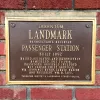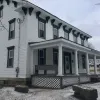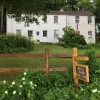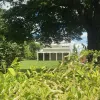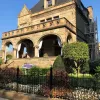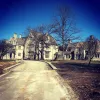In 1754, Jonathan Hill lived in the Fayette County area and was one of its earliest settlers. He first owned property in what is now known as Smock in 1785. He owned 105 acres, two horses, and one cow. He also owned one of the first grist mills in 1790, with his location on Redstone Creek.
Historic Houses
Kane Armory was built in 1922 for the 112th Infantry of the Pennsylvania National Guard, with a front administrative section added later, in 1929. It is one of at least thirty-seven armories in Pennsylvania laid out on a T plan. The armory was designed by W. G. Wilkins Company and Joseph F.
The Tarentum Station was built in 1892 and moved to its present location in 1913. It has welcomed many important visitors, including Kit Carson, William Jennings Brian, Carrie A. Nation, and President Willaim Howard Taft.
The original residential portion of the Club was built for Warren businessman Myron Waters (1817- 1901), who was said to have been the third wealthiest man in Warren when he built his new mansion on Market Street in 1872. Waters had come to Warren ca.
Located in Meadville, the Baldwin-Reynolds House was once home to Supreme Court Justice Henry Baldwin (1780-1840) and, at other times, two of Meadville's mayors. Purchased by the Meadville Historical Society, the house now includes an ice house, tannery, garden, and spring-fed pond.
The Drake Log Cabin is an 18' x 22' rectangular-shaped, one-room log cabin. Its hand-hewn shaped logs alternate with layers of mud mortar. A split-shingle-covered, gable roof with an interior end stone chimney tops the IH story cabin.
Have you ever wondered where the first colonial settlement in northwest Pennsylvania was located? Well, look no further than Meadville. In 1787, at the age of 36, David Mead and his brother, John, went scouting the northwestern Pennsylvania wilderness for a new location to settle.
Abel Colley was a son of Peter Colley who had an early tavern (Peter Colley Tavern) on the National Road nearly two miles northwest of this building in Redstone Township. Reputedly, Abel Calley's tavern-keeping enabled him to accumulate a fortune.
Most of us are familiar with the story of Johnny Appleseed—the barefoot, bearded, coffee-sack-and-tin-pan-hat-wearing wanderer who traversed the American wilderness in the early 1800s, casting seeds and giving rise to umpteen apple trees across the Midwest.
Born in Northumberland County on December 15, 1792, to Irish immigrants John and Mary Fullerton Irvine, Guy C. Irvine arrived in Brokenstraw Township in 1817.
On April 22, 1976, the Marshall House became the first building in Armstrong County to be added to the Pennsylvania Inventory of Historic Places. In May 1976, it was also placed on the National Register of Historic Places.
Providence Meeting House memorializes this region's Quaker pioneers and early settlers. The highly respected Society of Friends has been uniquely identified with our state since the day of its founder, William Penn.
This modest five-room farmhouse in Springdale, Pennsylvania, is the birthplace and childhood home of Rachel Carson, the ecologist whose groundbreaking 1962 book Silent Spring awakened global awareness of environmental responsibility.
Baker Mansion initially was the home of Elias Baker and his family. It now hosts the museum, the county historical society, and a library with a historical archive.
Go back over a hundred years and take a new look at a period in Pittsburgh’s history often characterized by the extremes of late 19th-century America: fabulous wealth and grinding poverty.
The Hyde Murphy Company built this home for William Carman after the turn of the century. William Carman was the son of Hiram Carman, who founded Carman, PA, along the Clarion River. The village is now only a ghost town located near where Portland Mills, PA is today.
In the late 19th century, the economic boom created by coal and Greensburg's growing importance as a retail and industrial center convinced the Pennsylvania Railroad to build its Train Station in Greensburg. The railroad commissioned architect William Cookman to design the new station.
The Hyde Murphy company completed this home in 1900 for the Cartwright family. Mr. Cartwright had previously owned much of the real estate in the Shawmut Valley. He amassed his fortune in both the lumber and masonry businesses.
The Greensburg Garden and Civic Center was built by philanthropist Katherine Mabis McKenna and donated to the City of Greensburg in 1969 as a memorial to her son, Mennel M. Smith.
In 1832, George Dickinson moved to Ridgway and settled along the Clarion River. He owned and operated two lumber mills and a mercantile store.
The Elizabeth Township Historical Society owns and maintains the historic 220-year-old Greenock Log House on Greenock Buena Vista Road. Conservation of this landmark building provides a distinctive opportunity to learn about rural life in this place as early as 1790.
In 1888, Pittsburgh businessman Russell H. Boggs commissioned a new home facing Pittsburgh's West Park, designed in a style known as Richardsonian Romanesque. Now, it is known as "Boggs Mansion" and serves as a small hotel.
The Lawrence mansion is maintained as a house that evokes the elegant lifestyle of the Lawrences rather than a museum. It houses an excellent collection of original English and American antiques.
The Howe-Childs Gateway House, once known as Willow Cottage, is one of Pittsburgh’s earliest frame cottage-style Gothic Revival houses. Built just before the Civil War, it was once part of a larger estate.


